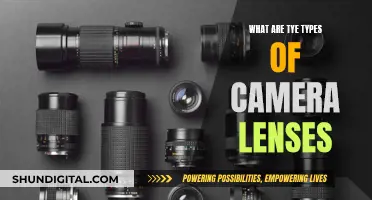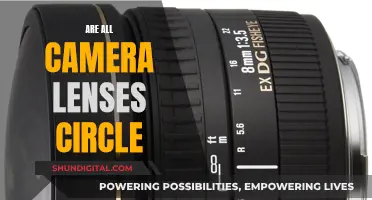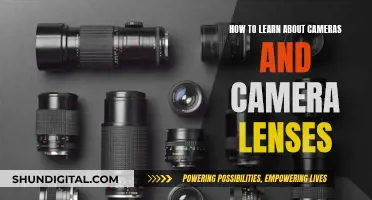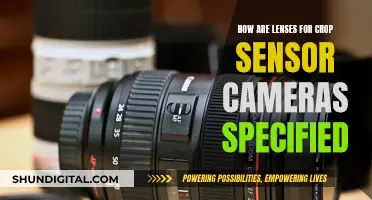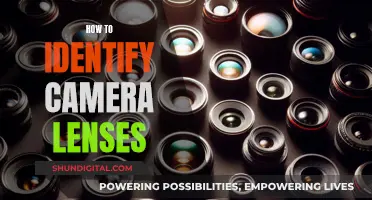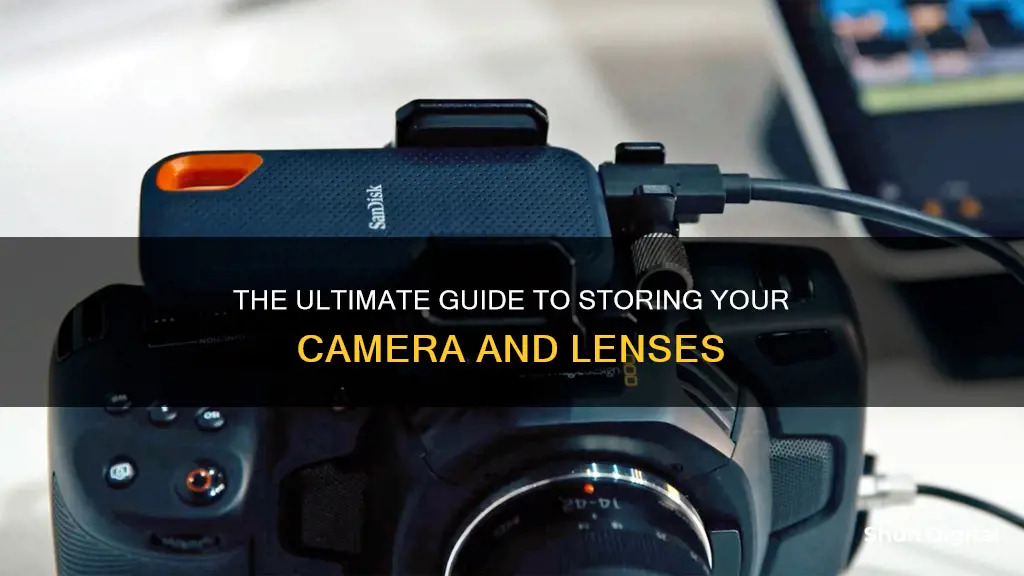
Cameras and lenses are delicate pieces of equipment that require careful storage to keep them in good condition. When not in use, they should be stored in a cool, dry place, as fungus and mildew can develop in humid environments, damaging the equipment. It is also important to protect them from dust, dirt, scratches, and extreme temperatures, which can affect image quality. To prevent damage, it is recommended to use storage solutions such as camera bags, dry cabinets, and lens pouches. These cases are designed to protect the equipment from physical damage, environmental factors, and humidity.
How to Store Cameras and Lenses
| Characteristics | Values |
|---|---|
| Store in a dry place | Keep lenses and cameras in a cool, dry location to avoid fungus and mildew. |
| Use airtight containers | Use airtight containers to keep fungus away. |
| Use silica gel | Include silica gel in the storage box to draw moisture away from the gear. |
| Use a dehumidifier | Use a dehumidifier to dry the air and prevent moisture. |
| Use a dry cabinet | Invest in a dehumidifier dry cabinet to keep your camera gear cool, dry, and protected from the elements. |
| Use a hard case | Use a hard case for protection from physical damage and environmental factors. |
| Use a camera bag | Use a camera bag to protect from scratches, dust, and moisture. |
| Use lens caps | Put the lens cap and hood on when not in use to prevent dust ingress and physical damage. |
| Store lenses front-element-side-down | Store lenses front-element-side-down to minimise the presence of oil in the aperture blades. |
| Use a screen protector | Use a screen protector to protect the LCD screen from scratches, fingerprints, and other types of damage. |
| Remove the camera battery and cards | Remove the camera battery and memory cards when storing to avoid corrosion and preserve battery life. |
What You'll Learn

Store lenses front-element-side-down to reduce oil in aperture blades
Storing lenses front-element-side-down is a good idea to reduce oil in the aperture blades. This is less of a concern with modern autofocus lenses, but it's better to be safe than sorry.
The practice of storing lenses front-element-side-down is based on the idea that oil can "seep" into the aperture blades over time if the lens is stored front-element-side-up. This can cause problems when trying to change the aperture later on. By storing the lens front-element-side-down, gravity will cause any oil to move away from the aperture blades, reducing the risk of oil buildup.
In addition to reducing oil in the aperture blades, storing lenses front-element-side-down can also have other benefits. For example, some people find it more convenient to store lenses this way, as it allows for faster lens changes. Storing lenses front-element-side-down can also help minimise dust accumulation on the front element, as gravity will cause dust to settle on the rear element instead.
However, there are differing opinions on the best way to store lenses. Some people argue that the rear of the lens is stronger and more robust than the front, so it makes sense to store the lens on its strongest end. Others claim that the front element is wider and heavier, so storing the lens front-element-side-down makes it less likely to fall or be knocked over. Ultimately, the best way to store lenses may depend on personal preference and the specific lenses being stored.
To reduce oil in the aperture blades and keep your lenses in good condition, it is also important to control humidity and avoid exposure to extreme temperatures. Consider investing in a dry cabinet or using desiccants to keep your lenses dry and free from moisture, which can lead to mould and fungus growth.
Packing Camera Gear: Travel-Ready in 10 Minutes
You may want to see also

Use dry cabinets to keep humidity away
Dry cabinets are a great way to keep your camera equipment safe from humidity. They are a specialised storage unit designed to maintain low humidity levels, protecting your gear from moisture-induced damage. This is important because high humidity can cause mould, rust, corrosion, and fungus to form on your camera and lenses, which can lead to malfunction and breakdown.
- Choose the right size: Dry cabinets come in various sizes, from small cabinets that can store a single camera and lens to large cabinets that can accommodate multiple cameras and lenses. Choose a cabinet that is suitable for the amount of equipment you need to store.
- Look for adjustable humidity control: Opt for a dry cabinet with precise humidity monitoring and control features. Look for models with digital displays and user-adjustable settings for optimal customisation. This will allow you to set the desired humidity level to protect your equipment.
- Ensure airtightness: It is important to choose a dry cabinet that is well-sealed and airtight to prevent moisture ingress. This will ensure that outside moisture cannot penetrate the cabinet and affect your equipment.
- Consider the build quality: Invest in a dry cabinet made from durable and high-quality materials. Look for cabinets constructed from steel, tempered glass, or other sturdy materials to ensure that it can withstand regular use and protect your equipment from damage.
- Compare different brands: There are several reputable brands of dry cabinets available in the market, such as Ruggard, T.A.P., FORSPARK, and Spolehli. Compare the features, price, and customer reviews of different brands to make an informed decision.
- Regular maintenance: Dry cabinets require regular maintenance to ensure optimal performance. Clean the cabinet periodically and check the seals for any signs of wear and tear. Follow the manufacturer's instructions for care and maintenance to prolong the life of your dry cabinet.
- Consider the location: Place your dry cabinet in a safe and dry location, away from direct sunlight, extreme temperatures, or areas prone to moisture. Ensure that the cabinet is easily accessible so that you can regularly monitor and maintain it.
Microscopic Dust: A Camera Lens Issue?
You may want to see also

Use silica gel to absorb moisture
When storing your camera and lenses, it's important to keep them in a dry place to prevent damage from moisture. One way to do this is by using silica gel to absorb moisture. Here are some tips on how to use silica gel effectively:
Choose the Right Type of Silica Gel
Silica gel comes in different forms, such as sachets, beads, and crystals. You can also find silica gel with a colour-changing indicator that shows when it's time to replace or regenerate the silica gel. Choose a type that is suitable for your storage container and camera equipment.
Ensure Proper Ventilation
Silica gel works by absorbing moisture from the air. If your camera equipment is stored in a sealed container, make sure there is adequate ventilation to allow the silica gel to absorb moisture effectively.
Use the Correct Amount
Use a sufficient amount of silica gel for the size of your storage container. It's generally recommended to use more silica gel than you think you need to ensure maximum moisture absorption. For small containers, 5-gram sachets or similar amounts of loose silica gel should be sufficient. For larger containers, consider using 20 to 60 grams or more.
Regularly Check and Replace Silica Gel
Silica gel has a saturation point, and once it's fully absorbed moisture, it will no longer be effective. Weigh the silica gel regularly to ensure it hasn't exceeded its absorption capacity. When the silica gel is fully saturated, you can either replace it with new silica gel or regenerate the used silica gel by baking it in the oven to remove the absorbed moisture.
Store Silica Gel Properly
To prevent silica gel from absorbing moisture before you need it, store it in a sealed container until you're ready to use it. Additionally, if you're using silica gel sachets, make sure they are not torn or damaged, as this can reduce their effectiveness.
Combine with Other Moisture-Prevention Methods
While silica gel is effective at absorbing moisture, combining it with other moisture-prevention methods will provide the best protection for your camera equipment. Use airtight storage containers, avoid storing equipment in humid environments, and consider investing in a dry cabinet or Pelican case for maximum protection.
Camera Lenses: Are Their Filters Universal?
You may want to see also

Store gear in an air-conditioned room
Storing your camera gear in an air-conditioned room is one of the best ways to ensure your equipment stays in top condition. Keeping your gear cool and dry prevents the growth of fungus, which thrives in hot and humid environments and can cause permanent damage to your lenses and camera bodies.
Fungus is a common issue with camera gear, especially in humid climates. It can grow on and around your camera lenses, and if left untreated, will decrease the image quality of your photos and videos. The little white splodges of fluff can make your images look fuzzy or hazy.
Air-conditioned rooms have low humidity, creating an environment that discourages the growth of fungus. By storing your gear in an air-conditioned room, you can rest assured that your equipment is protected from the damaging effects of moisture.
However, it is important to note that extreme temperature changes can also be harmful to your gear. Rapid changes in temperature can cause condensation to form on lenses, potentially leading to issues such as warped optics and decreased image quality. Therefore, it is recommended to avoid setting the temperature too low in very hot and humid climates, as this can cause condensation when removing the gear from the air-conditioned room. Instead, opt for a moderate temperature that will keep your gear cool and dry without causing drastic temperature changes.
Additionally, allow your gear to acclimatise by removing it from the air-conditioned room about 30 minutes before you need to use it. This way, you can avoid any potential issues caused by sudden temperature changes.
In summary, storing your camera gear in an air-conditioned room is a great way to protect it from the damaging effects of heat and humidity. By maintaining a moderate temperature and allowing your gear to acclimatise, you can ensure your equipment stays in optimal condition and continues to deliver high-quality performance.
Recycling Camera Lenses: A Guide to Sustainable Photography
You may want to see also

Use a dehumidifier to dry the air
To effectively store your camera and lenses, you need to combat the two biggest dangers to your equipment: blunt force and humidity. While investing in a protective camera bag is a good first step, it's also important to consider how to protect your gear from humidity, which can lead to lens fogging, fungal growth, and water damage.
One effective solution is to use a dehumidifier to dry the air and regulate humidity levels. Here are some tips on how to use a dehumidifier for storing your camera and lenses:
- Choose the Right Dehumidifier: Select a dehumidifier specifically designed for camera equipment storage, such as a dry cabinet dehumidifier. These cabinets are temperature-controlled, dehumidified, and airtight, ensuring your gear stays dry and protected.
- Size and Capacity: Dry cabinets come in various sizes, so choose one that can accommodate your camera bodies and lenses comfortably. Consider the amount of gear you have and select a cabinet with adjustable shelves to customize the storage space.
- Temperature and Humidity Control: Look for a dehumidifier with temperature and humidity control features. This will allow you to maintain optimal temperature and humidity levels to prevent lens fogging and mould growth. Aim for a relative humidity between 35% and 60%.
- Locking System: Opt for a dehumidifier with a locking system to secure your valuable camera equipment. This adds an extra layer of protection and prevents unauthorised access.
- Rapid Dehumidifying Technology: Choose a brand that offers rapid dehumidifying technology to efficiently remove moisture from the air. This feature ensures that your camera gear is stored in a dry environment, reducing the risk of damage caused by excess humidity.
- Customer Service: Consider the customer service provided by the manufacturer or brand. As you may be using the dehumidifier for long-term storage, it's important to have a responsive and reliable support team to assist with any issues or queries.
- Price and Value: Dry cabinets can range in price from $200 to $700. Compare features, capacity, and reviews to find the best value for your budget. Remember, investing in a dehumidifier is crucial for protecting your expensive camera gear.
- Regular Maintenance: Ensure you maintain your dehumidifier according to the manufacturer's instructions. This may include cleaning or replacing filters, refilling or recharging desiccant packs, and periodically testing the unit to ensure it's functioning optimally.
- Placement and Ventilation: Place your dehumidifier in a well-ventilated area to maximise its effectiveness. Avoid cramped spaces or areas with limited airflow, as this may hinder the dehumidifier's ability to regulate humidity effectively.
- Monitor Humidity Levels: Use a hygrometer to monitor the humidity levels in your storage area. This will help you ensure that the dehumidifier is maintaining the desired humidity levels and allow you to make adjustments as needed.
By following these guidelines and investing in a suitable dehumidifier, you can effectively dry the air and create optimal storage conditions for your camera and lenses, safeguarding them from the damaging effects of excess humidity.
Black Friday Camera Lens Deals: What to Expect
You may want to see also
Frequently asked questions
The biggest dangers are blunt force (dropping, smashing, cracking) and humidity.
Invest in a protective camera bag and a neck or hand strap.
Store your camera gear in an airtight container, preferably a dry cabinet.
A dry cabinet is a temperature-controlled, dehumidified, airtight, electronic cabinet that prevents mildew, rust, mold, fungus, rust, oxidation, and even insects from damaging your camera gear.
FORSPARK, Ruggard, T.A.P, StateRiver, and Slinger.


